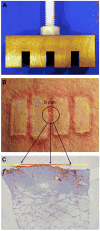Spatiotemporal progression of cell death in the zone of ischemia surrounding burns
- PMID: 22092800
- PMCID: PMC3664279
- DOI: 10.1111/j.1524-475X.2011.00725.x
Spatiotemporal progression of cell death in the zone of ischemia surrounding burns
Abstract
Burns are dynamic injuries, characterized by progressive death of surrounding tissue over time. Although central to an understanding of burn injury progression, the spatiotemporal degrees and rates of cellular necrosis and apoptosis in the zone of ischemia surrounding burns are not well characterized. Using a validated porcine hot comb model, we probed periburn tissue at 1, 4, and 24 hours after injury for high-mobility group box 1 as a marker of necrosis and activated cleaved caspase-3 as a marker of apoptosis, followed by spatiotemporal morphometric analysis. We found that necrosis was the most prominent mechanism of cell death in burn injury progression, with significant progression between 1 and 4 hours postburn. Apoptosis appeared not to play a role in early burn injury progression but was observed in cells at the interface of necrotic and viable tissue at 24 hours postburn. Our findings imply that intervention within the first 4 hours following injury is likely necessary to limit burn injury progression. Additionally, based on high-mobility group box 1 staining patterns, we define distinct early, intermediate, and late pathological signs of cell necrosis that may facilitate delineation of causal mechanistic relationships of burn injury progression in vivo.
© 2011 by the Wound Healing Society.
Figures








References
-
- Jackson DM. The diagnosis of the depth of burning. Br J Surg. 1953;40(164):588–596. - PubMed
-
- Singh V, Devgan L, Bhat S, Milner SM. The pathogenesis of burn wound conversion. Ann Plast Surg. 2007;59(1):109–15. - PubMed
-
- Gravante G, Delogu D, Palmieri MB, Santeusanio G, Montone A, Esposito G. Inverse relationship between the apoptotic rate and the time elapsed from thermal injuries in deep partial thickness burns. Burns. 2008;34(2):228–33. - PubMed
-
- Gravante G, Palmieri MB, Esposito G, Delogu D, Santeusanio G, Filingeri V, Montone A. Apoptotic death in deep partial thickness burns vs. normal skin of burned patients. J Surg Res. 2007;141(2):141–45. - PubMed
-
- McNamara AR, Zamba KD, Sokolich JC, Jaskille AD, Light TD, Griffin MA, Meyerholz DK. Apoptosis is differentially regulated by burn severity and dermal location. J Surg Res. 2010;162(2):258–63. - PubMed
Publication types
MeSH terms
Substances
Grants and funding
LinkOut - more resources
Full Text Sources
Other Literature Sources
Medical
Research Materials

